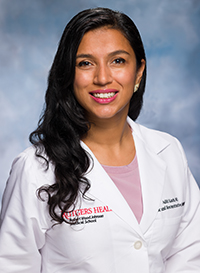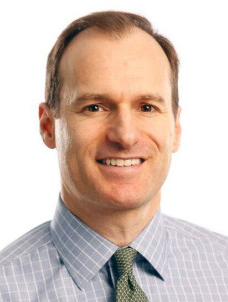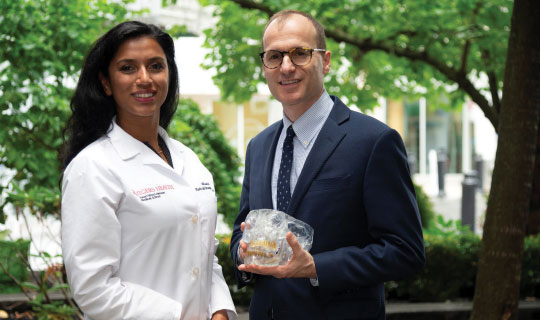How to treat cleft lip, cleft palate and other craniofacial differences.

Some parents may encounter craniofacial problems like cleft lip and cleft palate only through charitable TV ads.
“A lot of people think these problems just affect kids in other countries,” says Aditi Kanth, MD, a craniofacial surgeon and pediatric plastic surgeon with The Bristol-Myers Squibb Children’s Hospital (BMSCH) at Robert Wood Johnson University Hospital and Assistant Professor at Rutgers Robert Wood Johnson Medical School (RWJMS). “But these are extremely common birth defects, and it’s important that parents have access to care for them.”
BMSCH now has a dedicated program that guides parents on treatments for craniofacial anomalies. The program, which began in March, provides care from a multidisciplinary team led by craniofacial surgeons with backgrounds in both plastic and ear-nose-and-throat procedures.
“It’s uncommon for a program to combine these and other disciplines for cleft care,” says Joseph Vella, MD, PhD, a facial plastic and reconstructive surgeon and an otolaryngologist/head and neck surgeon at BMSCH, and Assistant Professor in the Department of Otolaryngology/Head and Neck Surgery and Chief of the Division of Facial Plastic and Reconstructive Surgery at RWJMS. “We offer comprehensive care to the community with an array of critical team members required for craniofacial interdisciplinary care.”

If you’re the parent of a child with a craniofacial abnormality, these steps can help guide care—and provide peace of mind.
Consider the Big Picture
Fixing a craniofacial defect such as cleft lip or palate isn’t a one-and-done surgery. “Kids tend to require an ongoing array of different specialists,” Dr. Kanth says. The BMSCH team includes specialists in areas such as oral surgery, pediatric dentistry, orthodontics, speech, feeding, pediatric genetics and pediatric neurosurgery. “Parents don’t need to piece together multiple specialists on their own,” Dr. Vella says. “We provide a one-stop shop where they can see all their specialists in one place, often in one visit.”
Begin Early
Craniofacial defects are often identified by ultrasound during pregnancy.
“We’re creating a pathway where expectant parents get a prenatal diagnosis and meet with us before the baby is born to determine what services will be needed and create a general operative plan,” Dr. Kanth says. “This streamlines care, and there’s evidence that this improves outcomes in terms of factors such as time to treatment and number of surgeries. It also tends to relieve anxiety for families.”
Create a Multistep Plan
“Kids can be born with an array of congenital facial differences or anomalies that may require surgeries and therapies throughout life or until they reach skeletal maturity,” Dr. Vella says.
Craniofacial problems can potentially lead to abnormalities in hearing, speech development and bone growth.
“We stay with our young patients as they get older to make sure all aspects of their craniofacial growth and development are on track,” Dr. Vella says.
A typical plan of care might entail surgery to repair a child’s cleft lip at 3 months, surgery to fix a cleft palate at 1 year and surgery to resolve skeletal issues in the jaw at age 8 or 9. Orthodontic and other care may also be required.
Some children need to address different craniofacial issues. One of the most common is a premature fusion of skull joints that prevents normal growth, which potentially can lead to pressure on the brain.
“At BMSCH, it’s easy to access specialists who can provide expert craniofacial care in a timely manner,” Dr. Vella says.
Sophisticated tools can help with treatment planning. These include 3D computer imaging, which can be combined with 3D printing to create physical models of a child’s face and head structures.
“Having something you can interact with virtually or physically is extremely helpful for efficient, targeted intraoperative planning,” Dr. Vella says.
Rest Assured
Receiving news that a child has a problem such as a facial difference can trigger parent anxiety.
“Talking about it and planning even before the birth can take a lot of weight and worry off parents’ shoulders,” Dr. Vella says. “It can be reassuring to realize we have many modalities available to restore facial appearance and that we are going to be with them every step of the way.”
“Most patients are completely normal kids who happen to have a facial difference,” Dr. Kanth says. “We provide care so kids can be kids and lead the lives they are meant to lead.”
What Are Cleft Lip and Cleft Palate?
Cleft lip and cleft palate are common birth defects that occur when facial structures don’t form properly during pregnancy. Clefts, or splits, in the upper lip or roof of the mouth may occur separately or together. Both can readily be corrected with surgery that restores appearance and protects against developmental problems that can result if clefts go untreated.
Cleft lip and cleft palate are among a range of craniofacial abnormalities that can develop during pregnancy. Other craniofacial problems include skull malformations that can prevent normal development but also can be corrected with surgery.
Learn more about comprehensive care at The Bristol-Myers Squibb Children’s Hospital at Robert Wood Johnson University Hospital.
